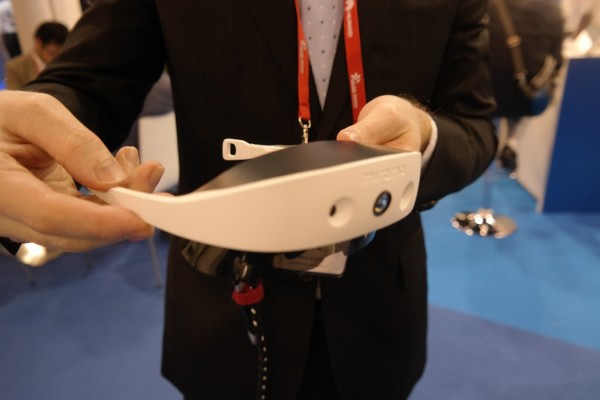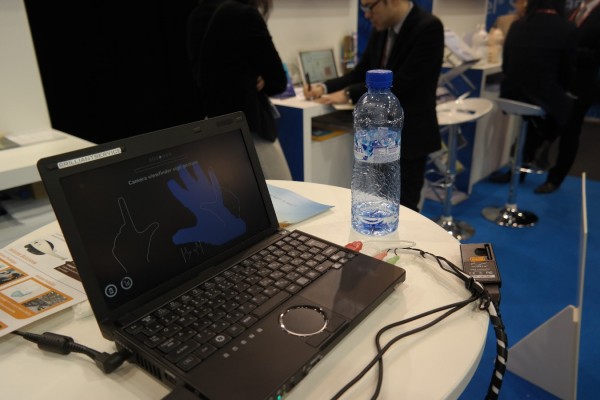Mirama Headset Takes Face, Gesture Recognition to Next Level
Why touch or talk to your wearable computer when you can just give it the finger? The product of Japanese company Brilliantservice, the Mirama headset and operating system let you send email, draw or perform a host of other actions just by gesturing. At last year's Mobile World Congress, the company showed an earlier version of the software, which was called the Viking OS and an earlier prototype of its headset. At this year's show, Brilliantservice Lead Developer Johannes Lundberg and his team were back with a new and improved version of the OS and a new set of prototype glasses. We had a chance to try on the Mirama prototype and came away even more intrigued by this product's potential.
MORE: Meta Pro AR Goggles Kick Google's Glass
The Mirama glasses we tried on were connected via USB to a PC laptop, which was running the software and showed a mirror on screen of what we were seeing in the glasses. Like the prototype Lundberg showed last year, the Mirama headset uses Vuzix glasses, in this case a binocular pair of Vuzix STAR 1200XLs.
The company has mounted its own camera set-up on top of glasses, with a 2-MP RGB camera, an infrared sensor and a time-of-flight camera, which uses the infrared signal to tell how far your hands are from your face. Though the glasses felt a bit bulky on our face, they easily fit over our glasses and we were able to see through both eyes.
Brilliantservice plans to start selling the prototype headset for 20,000 Euros (that's not a typo) a pair to developers who want a chance to build apps for the Mirama OS, but Lundenberg told us the company wants to license out its OS to OEMs, rather than becoming a hardware vendor. The glasses, while useful for experiencing the OS, would not work as an end user device because they need to be connected to a PC to work.
In our brief hands-on, we ran a demo app designed to showcase the Mirama OS's gesture-centric UI. At first, the app took us through a tutorial, making us perform certain gestures such as holding both of our thumbs up to frame a picture or giving thumbs up to indicate our approval of an action (like hitting "ok").
After we completed the tutorial, the software prompted us to shoot a photo by sticking our thumbs and index fingers out as if we were framing a picture and either clicking the shutter by curling our right index finger or hitting the timer button on screen and waiting three seconds. We chose the on-screen timer button, which we some trouble pressing but eventually targeted with our index finger.
Sign up to receive The Snapshot, a free special dispatch from Laptop Mag, in your inbox.
MORE: Google Glass vs. Smartphone: Which is Faster?
To press a button in Mirama OS, you must move the tip of your finger further away from your face so it gets closer to the virtual objects in front of you. To avoid hasty presses, the system makes you hold your finger in place for a second or two while it draws a green ring around the object.
After we took the photo, we were asked whether we wanted to keep or discard it and we indicated our approval by giving a thumbs up (a thumbs down would have rejected it). The software then asked us to pick a recipient for our email message and put a small circular crosshairs in front of our face. We moved our head and adjusted our gaze until the circle surrounded Lundberg's head. The software recognized his face and put his name on the screen, after which we pressed an on-screen button to confirm our choice. The system simulated sending an email to him and receiving a response asking us where we would like to meet, after which we pressed a maps button which presented us with a fake map with a few locations on it.
We chose Starbucks from among the locations highlighted on the map and then the system presented us with a virtual blank piece of paper to write a follow-up note on. We were supposed to use our finger to draw a reply on this screen but we weren't skilled enough to trace letters with our finger so we just scribbled some lines. A virtual keyboard would have been welcome here. After we were done scrilbbing, our demo was over.
The Mirama application we used was clearly rough around the edges, but there's strong potential for creating a compelling gesture controlled, augmented-reality environment with this platform, if an OEM licenses it and developers follow suit. The company has just started taking order requests for the prototype through its Mira.ma website so we'll see whether Mirama can find a place in this growing market.




